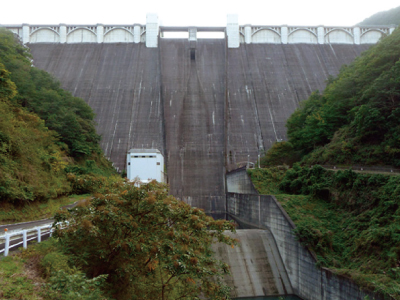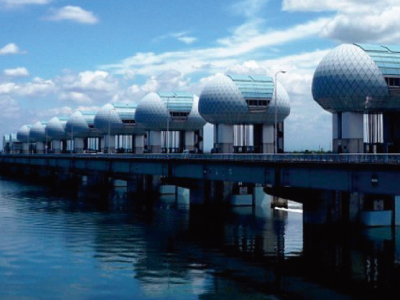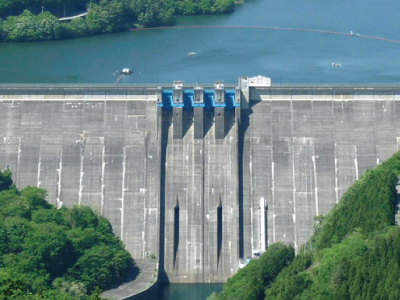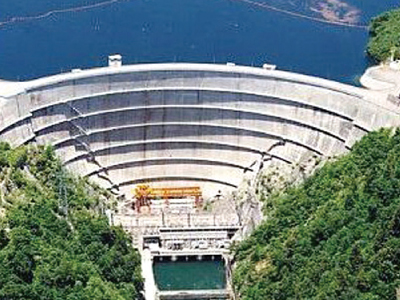A concrete dam is a dam constructed from concrete and can be sub classified into "a gravity type" and "an arch type." A gravity type dam resists the water pressure using the weight of the dam itself. An arch type dam resists the water pressure transferring pressure to the right and left abutments and the foundation.
[2] Fill Dams
A fill dam is a dam constructed from rock and soil materials. This type of dam allows the construction of a large scale dam even on relatively soft ground. Depending on the materials used, a fill dam can also be further classified. A dam constructed using rock, gravel, or soil materials, and stabilized with rock, and stop water from seeping through the dam with impermeable material is called "a zone type" fill dam. In contrast, a dam constructed using uniform material is called "an uniform type" fill dam, which type corresponds historically to a pond built in ancient times.
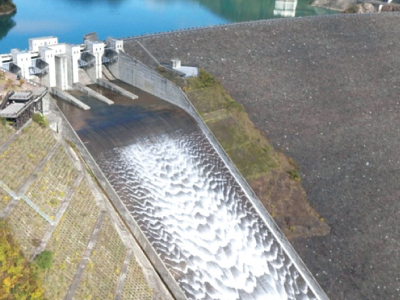
A rock-fill type dam (Tokuyama Dam)
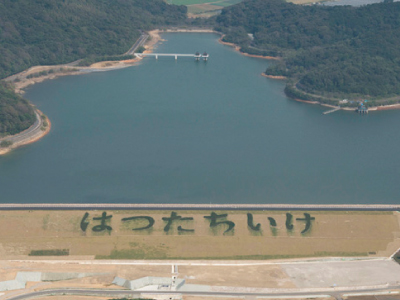
A earth-fil type dam (Toyogawa Canal/ Hatsutachi Pond)
Purposes of Dams
The purposes of dams are summarized as follows.
- [1]Flood Control
- [2]Maintenance of Normal Function of River
- [3]Agricultural (Irrigation) Water
- [4]Domestic Water
- [5]Industrial Water
- [6]Power Generation
[1]Flood Control
Rivers in Japan are generally shorter and steeper compared to those in other countries. Following heavy rains, water flows downstream rapidly. The flow's strong momentum often floods rice and vegetable fields with large volumes of water, damage crops, inundate homes, and sometimes with loss of life. A dam temporarily stores that massive amount of inflow water and plays a leading role in reducing downstream flood damage by controlling the water flow.
[2]Maintenance of Normal Functions of River
To maintain river flow throughout the year for navigation, fishing, sightseeing, groundwater preservation, conservation of water environment, or securing vested water and other uses, a dam releases its stored water when the downstream river flow is insufficient.
[3]Agricultural (Irrigation) Water
A dam also plays a role in storing water necessary for irrigation. It helps maintain a steady supply of water to paddy fields from the river even during the times of low river flow.
[4]Domestic Water
Another function of a dam is to store water necessary for domestic water supply. The stored water is discharged to a river when water in the river is scarce. It helps supply water stably to homes for drinking, a bath, and washing via water purification plant.
[5]Industrial Water
A dam also stores water for industrial use and discharges it to a river when the river water is insufficient. It helps supply water stably to plants and other industrial facilities.
[6]Power Generation
Water stored in a dam is discharged to the downstream to generate electricity by turning the turbine of the generator by the momentum of the water. Since hydropower does not use fossil fuels at all because it is operated by the acquired momentum of the potential energy or the gravity of water. For this reason, it does not generate carbon dioxide, and it is clean energy and friendly to Mother Nature.
Japan Water Agency (JWA) has constructed and manages a number of dams that have multiple roles. So they are called "multipurpose dams" as they can play multiple roles and objectives. Since the equipment in the dams can be used for several purposes, it is considered to be more economical than building plural dams for different proposes.
Dam Facilities
A dam has varied facilities for executing works such as flood control and water supply.
[1]Discharging Facilities
A dam has facilities for discharging water – water outlet, which makes water flow to the downstream of the river. It releases water to meet assumed purposes. This is one of the most fundamental functions of a dam.
Outlet Valves
An outlet valve is a facility for discharging stored water to supply the necessary water in the downstream area. Not only for this purpose, but it is also used when the inflow to the dam begins to increase in the initial stage of the flooding.
Principal Spillways
It is a facility used for flood control. If a dam has two types of spillway, "principal spillway" and "emergency spillway," the principal spillway is used to deal with floods equal or less than design flood.
Emergency Spillways
If the flood exceeds the design flood and water in the reservoir exceeds its storage capacity, the same amount of water flowing into the dam is then discharged to the downstream through an emergency spillway. A spillway acts to protect the safety of the dam itself.
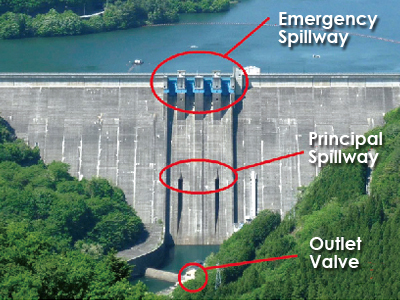
Discharging facilities (example of Kusaki Dam)
[2]Rainfall and Water Level Observation Facilities
These are facilities to observe the water level and precipitation running into a river to perform proper management of a dam to meet the rainfall or whatever situations. It acts as the eyes of a dam, operating 24 hours a day, and automatically transmits observed data to the dam management office.
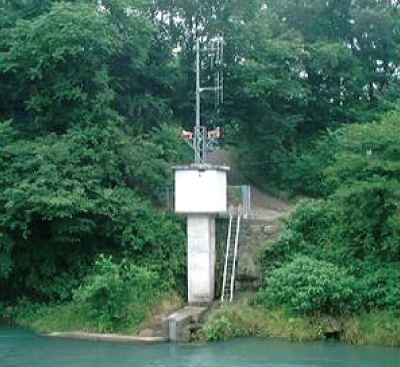
Water level observation station
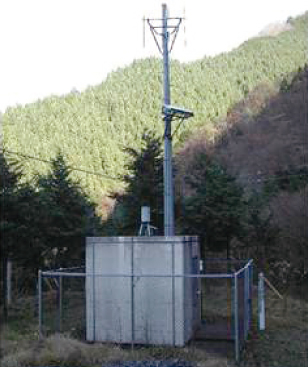
Rainfall observation station
[3]Discharge Warning Equipment /Information Display Panels
When a dam discharges water to the downstream, the water level of the river may rise suddenly. It is very dangerous to stay in or on the river, so it is necessary to inform people staying along the river or anglers or other visitors of such information by broadcasting or texting. Thus, warning equipment and information display panels are installed at certain spots in the downstream area of the dam. At the same time, JWA conducts patrol using a patrol vehicle equipped with red lights and loud speakers.
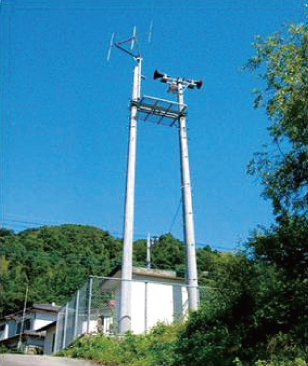
Discharge warning equipment
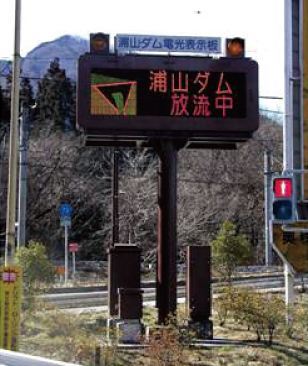
Information display panel
[4]Other Facilities
There are some other facilities necessary for managing a dam. Some of them are shown below.
Boats and Mooring Facilities
A boat is used to inspect a reservoir and conduct water quality inspections. It is stored in a mooring facility not to be swept away by a flood.
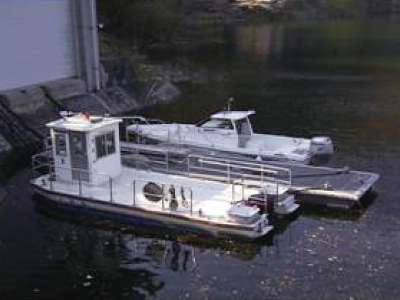
Boats
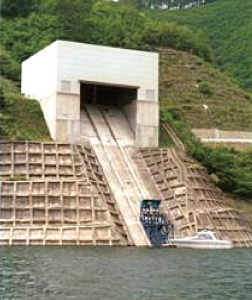
Mooring facility
Trash Booms and Ship Gates
Garbage and driftwood may flow into the reservoir and cause trouble to dam operation and maintenance. So called "Aba (trash boom)" is spread on the surface so that they won't flow into an intake or a spillway gate. The trash boom and ship gate are installed as united equipment, so that a boat can navigate through the trash boom for management.
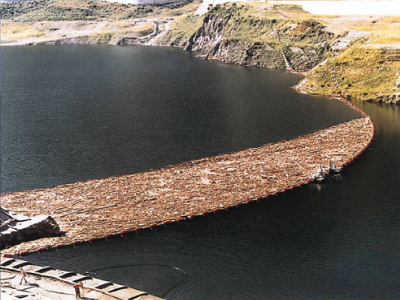
Trash boom
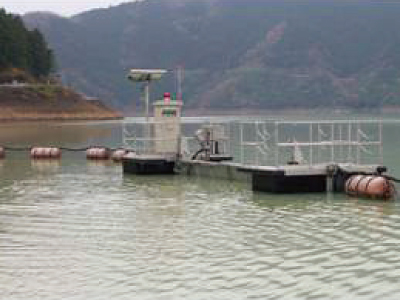
Ship gate

